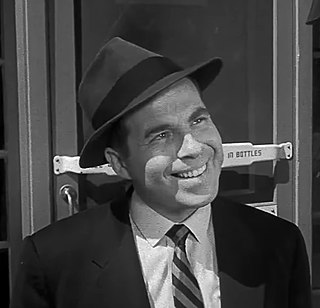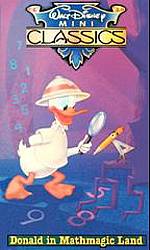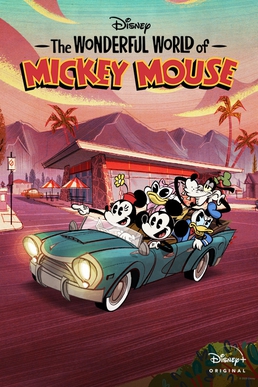
Professor Ludwig Von Drake is a cartoon character created in 1961 by The Walt Disney Company. He is the paternal uncle of Donald Duck. He was first introduced as the presenter in the cartoon An Adventure in Color, part of the first episode of Walt Disney's Wonderful World of Color on NBC. According to the episode The Hunting Instinct of that series he and Donald Duck's father are brothers. He is described as a scientist, lecturer, psychologist, and world traveler. The character displayed his "expert" knowledge on a variety of subjects in eighteen episodes of the classic anthology series, as well as on a number of Disneyland Records.

The Mickey Mouse Club is an American variety television show that aired intermittently from 1955 to 1996 and briefly returned to social media in 2017. Created by Walt Disney and produced by Walt Disney Productions, the program was first televised for four seasons, from 1955 to 1959, by ABC. This original run featured a regular, but ever-changing cast of mostly teen performers. ABC broadcast reruns weekday afternoons during the 1958–1959 season, airing right after American Bandstand. The show was revived three times after its initial 1955–1959 run on ABC, first from 1977 to 1979 for first-run syndication as The New Mickey Mouse Club, then from 1989 to 1996 as The All-New Mickey Mouse Club airing on The Disney Channel, and again from 2017 to 2018 with the moniker Club Mickey Mouse airing on internet social media.

Mickey Mouse Works is an American animated television series produced by Walt Disney Television Animation featuring Mickey Mouse and his friends in a series of animated shorts. The first Disney television animated series to be produced in widescreen high definition, it is formatted as a variety show, with skits starring Mickey Mouse, Minnie Mouse, Donald Duck, Daisy Duck, Goofy, Pluto and Ludwig Von Drake while Horace Horsecollar, Clarabelle Cow, Morty and Ferdie Fieldmouse, Huey, Dewey and Louie, Chip 'n' Dale, Scrooge McDuck, Pete, Humphrey the Bear, J. Audubon Woodlore, Dinah the Dachshund, Butch the Bulldog, Mortimer Mouse, José Carioca, and Clara Cluck appear as supporting or minor characters. Musical themes for each character were composed by Stephen James Taylor with a live 12-piece band and extensive use of the fretless guitar to which the music of the series was nominated for an Annie Award in both 1999 and 2001. Most of the shorts from the series were later used in House of Mouse.

Quack Pack is an American animated sitcom produced by Walt Disney Television Animation, featuring Donald Duck and his nephews Huey, Dewey, and Louie. The show debuted on September 3, 1996 as a part of the "Disney Afternoon" programming block, following the success of Goof Troop, and ran for one season with 39 episodes.

The Walt Disney Company has produced an anthology television series since 1954 under several titles and formats. The program's current title, The Wonderful World of Disney, was used from 1969 to 1979 and again from 1991 onward. The program moved among the Big Three television networks in its first four decades, but has aired on ABC since 1997.

The Sherman Brothers were an American songwriting duo that specialized in musical films, made up of brothers Robert Sherman and Richard Sherman. Together they received various accolades including two Academy Awards and three Grammy Awards. They received nominations for a Laurence Olivier Award, a BAFTA Award, and five Golden Globe Awards. In 1976, they received a star on the Hollywood Walk of Fame, and the National Medal of the Arts in 2008.

Solomon Hersh Frees, better known as Paul Frees, was an American actor, comedian, impressionist, and vaudevillian. He is known for his work on Metro-Goldwyn-Mayer, Walter Lantz, Rankin/Bass and Walt Disney theatrical cartoons during the Golden Age of Animation, and for providing the voice of Boris Badenov in The Rocky and Bullwinkle Show. Frees was known as "The Man of a Thousand Voices", though the appellation was more commonly bestowed on Mel Blanc.

Fun and Fancy Free is a 1947 American animated musical fantasy anthology film produced by Walt Disney and Ben Sharpsteen and released on September 27, 1947 by RKO Radio Pictures. The film is a compilation of two stories: Bongo, narrated by Dinah Shore and loosely based on the short story "Little Bear Bongo" by Sinclair Lewis; and Mickey and the Beanstalk, narrated by Edgar Bergen and based on the "Jack and the Beanstalk" fairy tale. Though the film is primarily animated, it also uses live-action segments starring Edgar Bergen to join its two stories.

Welcome to Pooh Corner is a live-action/puppet television series that aired on Disney Channel, featuring the characters from the Winnie the Pooh universe portrayed by actors in human-sized puppet suits, except Roo, who was originally a traditional puppet. The animatronic costumes used for the characters were created by Alchemy II, Inc., headed by Ken Forsse who later created Teddy Ruxpin. The show was first aired on April 18, 1983, the day The Disney Channel was launched. Its timeslot for its early run was at 8:30 a.m. Eastern/Pacific Time, making it the third program of The Disney Channel's 16 hour programming day. Reruns of the show aired on The Disney Channel until May 30, 1997.

Donald in Mathmagic Land is an American live-action animated featurette produced by Walt Disney Productions and featuring Donald Duck. The short was directed by Hamilton Luske and was released on June 26, 1959. It was nominated for an Academy Award for Best Documentary at the 32nd Academy Awards, and became a widely viewed educational film in American schools of the 1960s and beyond.

Mickey's Magical Christmas: Snowed in at the House of Mouse is a 2001 animated direct-to-video Christmas comedy fantasy crossover film. It includes two Disney short films, 1952's Pluto's Christmas Tree and 1983's Mickey's Christmas Carol, as well as three 1999 episodes of Mickey Mouse Works.

Disney Sing-Along Songs is a series of videos on VHS, betamax, laserdisc, and DVD with musical moments from various Disney films, TV shows, and attractions. Lyrics for the songs are sometimes displayed on-screen with the Mickey Mouse icon as a "bouncing ball". Early releases open with a theme song introduction containing footage featuring Professor Owl and his class, seen originally in 1953 in two Disney shorts, Melody and Toot, Whistle, Plunk, and Boom. Professor Owl hosts some of the videos, while either Jiminy Cricket or Ludwig Von Drake host others. Later volumes, as well as the two Christmas videos, do not feature a host at all. Scenes with Jiminy Cricket and Ludwig Von Drake were taken from television programs, including the Walt Disney anthology television series and The Mickey Mouse Club, which featured the characters in the 1950s and 1960s.

A Symposium on Popular Songs is a special cartoon featurette made by Walt Disney Productions in 1962. It features songs that were written by the Sherman Brothers, with music arrangements by Tutti Camarata. The Shermans also co-wrote the screenplay but are not credited for this. Host Ludwig Von Drake invites his audience into his mansion where he tells all about popular music through the years, introducing several songs illustrated with stop-motion photography. The film was nominated for an Academy Award for Best Animated Short Film.
D-TV is a music video television series produced by Charles Braverman and edited by Ted Herrmann. Premiering on May 5, 1984 on the Disney Channel, the series combined both classic and contemporary popular music with various footage of vintage animated shorts and feature films from The Walt Disney Company, created out of the trend of music videos on cable channel MTV, which inspired the name of this series.
"The Spectrum Song" was written by the Sherman Brothers in 1961 under assignment from Walt Disney to be a signature song for the fictional character Ludwig Von Drake. Nominally about different colors in the spectrum, the song's lyrics initially consist of the repeated color names red, yellow, green and blue, but soon veer wildly off into cerise, chartreuse, ultramarine and plaid.

World of Color is a nighttime show at Disney California Adventure in the Disneyland Resort in Anaheim, California. Conceived by Vice President of Parades and Spectaculars Steve Davison, and designed by Disney Live Entertainment, the show has 1,200 water fountains and includes lights, fire, lasers, and fog, with high-definition projections on mist screens. The show is inspired by Walt Disney's Wonderful World of Color anthology television series, as evidenced by the use of its eponymous theme song written by the Sherman Brothers.
The Spirit of Mickey is an American animated direct-to-video anthology film, produced and released by Walt Disney Home Video on July 14, 1998. It features clips from The Mickey Mouse Club, The Wonderful World of Disney, and A Goofy Movie, in the introductory scene, and some of the namesake character's shorts, including The Band Concert, Lend a Paw, Mr. Mouse Takes a Trip and Steamboat Willie.
Mickey Mouse Mixed-Up Bounds is an American animated children's television series that was broadcast on Disney Junior. Produced by Disney Television Animation, the series is the successor to Mickey Mouse Clubhouse. Originally airing as Mickey and the Roadster Racers for its first two seasons, it debuted on its first two episodes consecutively on January 15, 2017.

The Wonderful World of Mickey Mouse is an American animated television series produced by Disney Television Animation for Disney+. The series is a continuation and revival of the Emmy Award-winning 2013 Mickey Mouse shorts, uses the same style, and has many of the same cast and crew, with the exception of the late Russi Taylor, who was replaced by Kaitlyn Robrock in the role of Minnie Mouse. The series premiered on November 18, 2020 to coincide with Mickey's 92nd birthday. The animation is provided by Mercury Filmworks.














